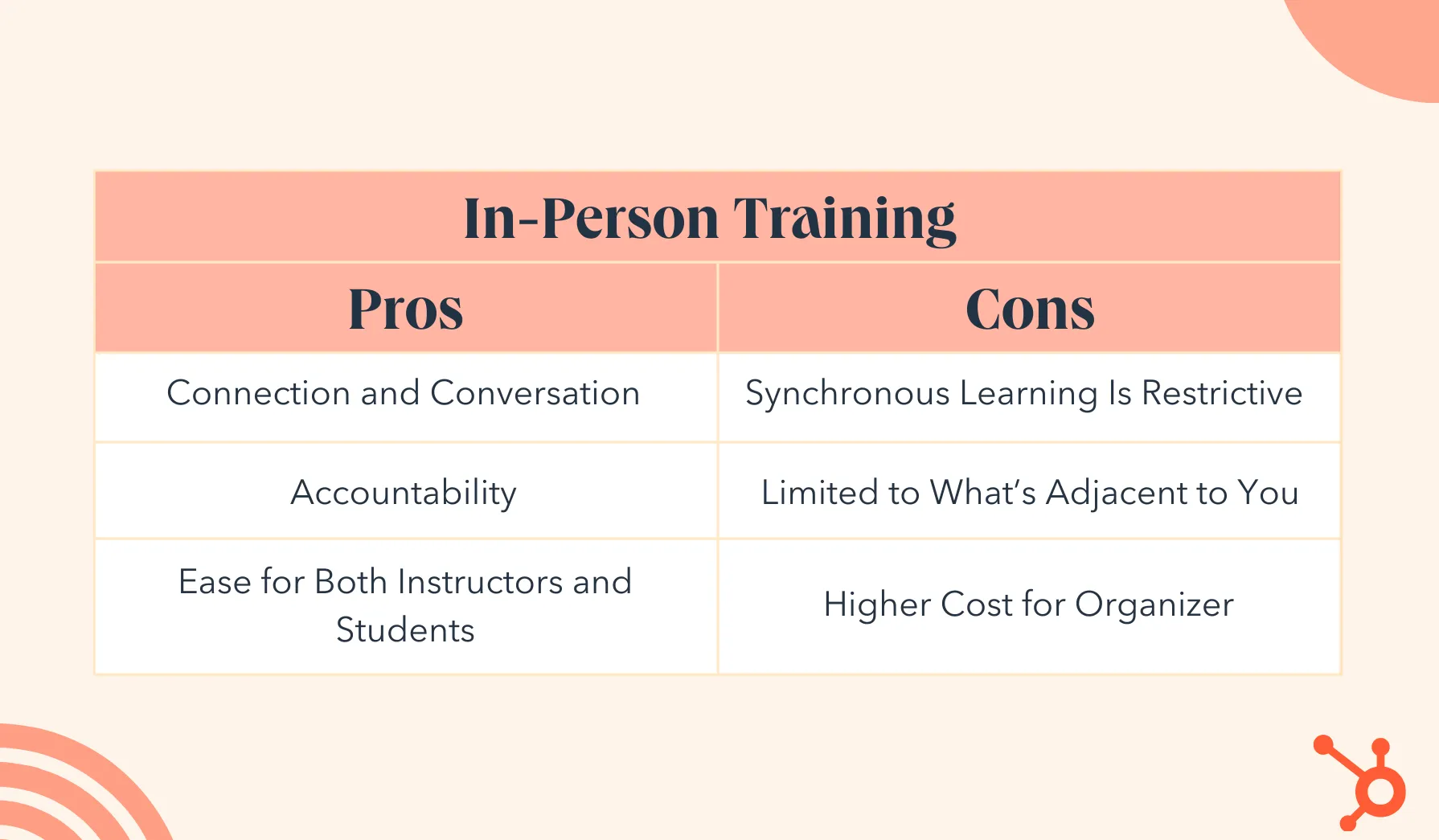The training industry went through massive changes in 2020. Almost every form of education went virtual, from workplace training to recreational courses. Now that we have two forms of training available, it begs the question: What are the real advantages and disadvantages of in-person and virtual training?

While choosing between online and in-person training may sound as simple as choosing Door A or Door B, it’s a watershed moment that opens organizations and potential learners up to a variety of gained and lost opportunities.
When asked which strategies would result in the most growth for their company, 19% of sales professionals selected improving training and career development opportunities (data from our upcoming 2024 State of Sales Report). Here’s how to tell what’s right for you.
Table of Contents
- Virtual vs. In-Person Training
- What is virtual training?
- Advantages of Virtual Training
- Disadvantages of Virtual Training
- What is in-person training?
- Advantages of In-Person Training
- Disadvantages of In-Person Training
- Which Should You Use — Virtual vs. In-Person Training?
Virtual vs. In-Person Training
In-person training takes place when an educator shares the same physical space with their learners. Virtual training takes place when the entire learning process is moved online, with both the educator and the learners being remote.
This may sound black and white, but there’s actually a spectrum of educational options, ranging from traditional in-person learning to online learning:
- In-person learning. Educators and learners share the same physical training space 100% of the time.
- Blended learning. Combines face-to-face meetings of educators and learners in the same physical training space with opportunities for asynchronous online interaction with content and each other.
- Hybrid learning. Educators share the physical training space with some learners, while others join the training virtually from other locations. Some asynchronous elements may also be present in the course design.
- Remote learning. Educators teach exclusively online to a 100% remote audience.
Definitions provided by educational specialist Tracy Poelzer.
What is virtual training?
Sometimes called e-learning, virtual training is a method of education that’s conducted online. This umbrella term encompasses one-off online courses taught by subject matter experts, all the way to advanced university degrees taught entirely through online learning.
The online learning market is thriving. It’s estimated that the online learning market size in the U.S. will grow by $48.4 billion between 2022 and 2027. When asked about satisfaction, 98% of online students responded positively and said they would recommend online learning to others.
The data is clear: Online learning is here to stay. Let’s look at what it offers.

Advantages of Virtual Training
While virtual training may feel like a 2020 phenomenon, it’s a well-established educational medium — one that’s been facilitating basic online training all the way to online master’s degrees for years. Here are the primary benefits of virtual training.
More Affordable for Learners
The online learning setting offers the most cost-effective educational path. In-person training programs come with various expenses that virtual training doesn’t have.
For learners, the costs of attending a class include the course itself, supplies, driving to a physical location, and paying for parking. While transportation costs may be nominal for some attendees, it will present a barrier for others.
Cost-effective online training programs create far more learning opportunities for more learners and stretch an organization’s budget further. In an online training environment, workplaces can bring multiple teams, branches, or divisions together to participate in one training that would otherwise require separate sessions.
Access hundreds of free online courses now in HubSpot Academy.
Flexibility of Asynchronous Learning
A traditional learning environment is synchronous, meaning that students and teachers engage with each other in real time. This is known as synchronous learning and is sometimes referred to as “live learning.” The opposite of that environment is asynchronous learning. This can come in the form of pre-written or pre-recorded materials or students working independently.
Educators in both virtual and in-person settings leverage both synchronous and asynchronous learning. For example, after teaching an in-person lesson:
- One teacher gives students 30 minutes to complete an assignment, and they must hand it in before they go (synchronous).
- Another teacher gives the assignment and instructs students to complete their unfinished work before they return to the next lesson (asynchronous).
Asynchronous online learning offers an incredible amount of flexibility for both educators and students. Instructors can develop their training on their own time, and students can complete the materials at their own pace. This has been the longtime selling point of advanced virtual degrees, and it’s one of the greatest benefits of virtual training.
Geographical Access
In-person learning creates unintentional barriers to education, such as geographical barriers. Those organizing trainings can only invite students who are physically nearby, and learners need to be available to leave the house during that specific timeframe.
“After teaching in-person calligraphy workshops in Ohio, we moved to virtual training due to the time constraints and lack of follow-up on our students’ lettering progress,” said calligraphy teacher Jillian Reece, co-founder of Loveleigh Loops. Since 2018, she and her co-founder have taught dozens of online courses to more than 30,000 students from 149 countries.
“Online teaching allows us to cover more content, foster a global community, and, from a practical standpoint, provides students with a closer view of our calligraphy pens than they could get sitting in the back of a classroom.”
.webp)
Removal of Barriers
Students miss out on learning opportunities when classes are only offered in person. Being able to learn from home opens up opportunities to those who have obstacles, such as those with young children and limited childcare or those with a disability.
Disadvantages of Virtual Training
While virtual training offers a bigger stage, there are negative aspects to trading a human for a screen. These are the disadvantages worth weighing while looking at digital versus in-person training.
Loss of Energy
Being in the same setting as other learners provides stimulation that virtual training just doesn’t replicate.
“Both types of training can be highly effective, but the exchange of energy in an in-person training is unparalleled,” said Bob Sager, workplace trainer of 15+ years and founder of SpearPoint Solutions. “Some of it’s lost, but you can maintain it by keeping group sizes small.”
Online, Sager thinks that 15 attendees is the limit to the number of people that a trainer can keep energized and engaged. In person? Sager estimates that number is 150.
Tools Are Unclear or Always Different
There are endless tools at your fingertips in the digital learning space. Maybe even too many, leaving students and educators with the feeling that they don’t know what tools can best serve them. Being asked to constantly try new platforms gives everyone a headache and makes people feel like they’re always being asked to reinvent the wheel.
Attendees lose patience for virtual training when every session uses a new platform with a new interface, new login information, new video conferencing software, and so on. For everyone involved, the constant need for adaptation to a new software or organizational system creates a cycle of fatigue and frustration.
“New tasks that require conscious thought are taxing,” said Sager. “We’re creatures of habits; conscious thought burns calories, and we avoid it.”
Time Intensive to Create
Educators and organizers have to invest significantly more time into remote learning to engage students.
“Good online learning is very time-intensive to design well,” said Tracy Poelzer, educational specialist at the University of Groningen. Poelzer helped professors transition from in-person to virtual learning during the pandemic and has since used blended learning techniques to help universities around the world integrate technology into their teaching.
“Many people feel a lack of connection with other participants in online courses. Building community in an online setting is much more challenging and requires time and intentional design. Trust and relationships between instructors and participants are foundational to good learning, so the effort is definitely worthwhile.”
Increased Pressure on Facilitators
These disadvantages culminate in added pressure on the training facilitator. For organizers, it’s hard, or sometimes impossible, to read the virtual room and keep learners engaged.
In large groups, educators can’t even see all of their attendees. Faces get smaller and smaller as more attendees join a live call, and you eventually hit the limit of the number of faces you can have on screen.
While both in-person and virtual training can be highly effective, virtual training requires more planning, forethought, and engagement from facilitators.
What is in-person training?
In-person training takes place when an educator shares the same space with all of their attendees. In-person training sessions can range from the traditional education sector, personal development such as a yoga class, or ongoing education for your profession.
Statistics rave about online learning and paint the picture of a clear winner and loser in the discussion of in-person versus online learning. Yet, educators tend to prefer face-to-face learning.
Here’s what professional trainers think about how face-to-face learning stacks up against online learning.

Advantages of In-Person Training
If the sky’s the limit with virtual training, then where do in-person training programs shine? Let’s examine the benefits that face-to-face training methods offer.
Connection and Conversation
Face-to-face training sessions provide human contact and stimulation that can’t easily be replicated online, and there’s a spark that happens when you’re alongside other learners sharing an area of interest. The social interaction that naturally evolves out of the physical learning space is incredibly powerful.
“Even after seven years of teaching online, I believe there’s no substitute for the power of peer-to-peer interactions, group discussions, and networking with instructors and fellow students,” said online English teacher Rachel Story, co-founder of Grateful Gnomads.
Story was an in-classroom English teacher in China for five years and became a virtual teacher in 2016.
“That real-life engagement is the greatest advantage of in-person training,” she says.
Accountability
While some students will thrive in the self-paced learning experience, others need face-to-face interaction to fully engage with their learning environment. The distractions students face, like multitasking or half-listening while scrolling social media, are too great a temptation for some to ignore.
In a physical setting, the pressure from the educator and fellow learners creates accountability to stay in the moment. Participants don’t have the choice to be completely uninvolved; they’re held accountable by both their peers and their instructors.
Ease for Both Instructors and Students
Walking into a classroom and finding an empty seat is a task that wouldn’t confuse a single class attendee, but there’s a percentage of every group that wouldn’t know how to log in and use Blackboard, Zoom, or Google Meet.
Hands-on learning is something that’s familiar to everyone. Online classes, on the other hand, may be a completely foreign concept to learners. This can create a barrier, whether it’s a real or perceived difficulty with technology.
The teaching process is easier with in-person training, with participants sometimes getting better learning outcomes as well. Students can request clarifications easily in a face-to-face learning environment, and receive hands-on help from teachers that some subjects really benefit from.
“It’s much easier to show someone something in person than it is online,” said Story. “I would much rather have a yoga class in person so the teacher can help me correctly form the poses so I get the maximum benefit of the practice. You get a faster response. When teaching in the same space, you need fewer words to explain how to do something.”
Disadvantages of In-Person Training Sessions
With energy, ease, and accountability waiting for you at an in-person training, what are the tradeoffs? Let’s explore the greatest drawbacks to face-to-face training.
Synchronous Learning Is Restrictive
With in-person training, learners lose the ability to move through educational materials at their own pace. It’s impossible to replay a live training session or reduce the speed at which the speaker is talking to improve your comprehension.
This can be very impactful for students who are taking training in a second or third language. These functions of virtual training really benefit some students.
“The shift from in-person training to virtual lettering lessons has offered our students ongoing support, access to advanced lessons, and the convenience of learning at their own pace,” said Reece. Those benefits were lost when her students could only learn through in-person classes.
Limited to What’s Adjacent to You
Being geographically limited means that both the available educators and the student groups are more homogeneous. When organizations are only able to offer education from local teachers to local students, the search for the top subject matter expert is reduced to finding someone locally available.
Before becoming an educational specialist in higher education, Poelzer was a K-12 teacher and technology integration specialist. She leveraged video conferencing tools to connect her students in rural Canada to experiences such as learning from NASA astronauts, “visiting” famous museums, and even joining a live, virtual underwater dive at the Great Barrier Reef.
“It’s often much easier than most teachers expect to expand the walls of your classroom in this way,” Poelzer shared.
Higher Cost for Organizer
In-person training can be extremely expensive for organizers compared to virtual training. Organizations that are hosting workshops or training sessions in a physical setting have to rent spaces and potentially pay for food for attendees. For their instructors, they’ll also have to pay for transportation and accommodation costs.
In our upcoming 2024 State of Sales Report, 21% of managers and sales professionals said that lack of training opportunities is most likely to negatively impact sales reps’ ability to succeed. Additionally, 20% of those managers and sales professionals said that training opportunities were among the most important ways to motivate sales reps.
Organizations have an important job stretching their training budgets.
Which Should You Use — Virtual or In-Person Training?
When organizing training for your team, which training methods should you choose?
Ask yourself these questions:
- Were the training materials specifically designed for virtual or in-person learning?
- What’s your team’s comfort level with technology and virtual learning?
- Is hands-on training required to really understand course material?
- What are your team’s learning styles? What do they prefer?
- Do learners have time for synchronous learning?
- What’s the quality of the education?
- Where is your team located? Are they in the same place or spread out?
When to Use In-Person Learning
If the time, budget, and experts are available to you, splurge on in-person learning. “If in-person training is a possibility, there’s nothing like the energy exchange and attentiveness of in-person training,” said Kimanzi Constable, founder of boutique education company Ubora Advisory.
“There’s the added advantage of accountability, human connection, and the ability to adjust training based on reading those in the room. Being in the room offers benefits that just can’t be transferred to virtual training.”
.webp)
When to Use Online Learning
When the time, budget, or local expertise is unavailable, turn to online learning. Online learning is a great way to save money, and cost-effective online training can still be extremely beneficial to organizations.
“There’s magic in ‘have to’ — when people have to figure something out, they will,” Sager encouraged.
Seek out blended learning opportunities when the team can’t train in person together to leverage the benefits of both synchronous and asynchronous learning.
Getting Started
Which kind of training lies in your future: in-person or virtual? Whether you’re organizing an electrifying face-to-face training or sitting at the feet of great minds from all over the world in virtual training, you can feel confident that you’re taking an essential step for your organization.


![How to Improve Sales Performance of Reps or Teams [Data & Expert Tips]](https://blog.hubspot.com/hubfs/improve-sales-team-performance%20%281%29.jpg)








